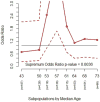Subpopulation Treatment Effect Pattern Plot (STEPP) analysis for continuous, binary, and count outcomes
- PMID: 27094489
- PMCID: PMC4942365
- DOI: 10.1177/1740774516643297
Subpopulation Treatment Effect Pattern Plot (STEPP) analysis for continuous, binary, and count outcomes
Abstract
Background: For the past few decades, randomized clinical trials have provided evidence for effective treatments by comparing several competing therapies. Their successes have led to numerous new therapies to combat many diseases. However, since their conclusions are based on the entire cohort in the trial, the treatment recommendation is for everyone, and may not be the best option for an individual. Medical research is now focusing more on providing personalized care for patients, which requires investigating how patient characteristics, including novel biomarkers, modify the effect of current treatment modalities. This is known as heterogeneity of treatment effects. A better understanding of the interaction between treatment and patient-specific prognostic factors will enable practitioners to expand the availability of tailored therapies, with the ultimate goal of improving patient outcomes. The Subpopulation Treatment Effect Pattern Plot (STEPP) approach was developed to allow researchers to investigate the heterogeneity of treatment effects on survival outcomes across values of a (continuously measured) covariate, such as a biomarker measurement.
Methods: Here, we extend the Subpopulation Treatment Effect Pattern Plot approach to continuous, binary, and count outcomes, which can be easily modeled using generalized linear models. With this extension of Subpopulation Treatment Effect Pattern Plot, these additional types of treatment effects within subpopulations defined with respect to a covariate of interest can be estimated, and the statistical significance of any observed heterogeneity of treatment effect can be assessed using permutation tests. The desirable feature that commonly used models are applied to well-defined patient subgroups to estimate treatment effects is retained in this extension.
Results: We describe a simulation study to confirm that the proper Type I error rate is maintained when there is no treatment heterogeneity, and a power study to show that the statistics have power to detect treatment heterogeneity under alternative scenarios. As an illustration, we apply the methods to data from the Aspirin/Folate Polyp Prevention Study, a clinical trial evaluating the effect of oral aspirin, folic acid, or both as a chemoprevention agent against colorectal adenomas. The pre-existing R software package stepp has been extended to handle continuous, binary, and count data using Gaussian, Bernoulli, and Poisson models, and it is available on the Comprehensive R Archive Network.
Conclusion: The extension of the method and the availability of new software now permit STEPP to be applied to the full range of clinical trial end points.
Trial registration: ClinicalTrials.gov NCT00272324.
Keywords: Generalized linear model; Subpopulation Treatment Effect Pattern Plot (STEPP); randomized clinical trial; subgroup analysis.
© The Author(s) 2016.
Conflict of interest statement
Figures




Similar articles
-
A Simulation Study Comparing Different Statistical Approaches for the Identification of Predictive Biomarkers.Comput Math Methods Med. 2019 Jun 13;2019:7037230. doi: 10.1155/2019/7037230. eCollection 2019. Comput Math Methods Med. 2019. PMID: 31312252 Free PMC article.
-
Identifying treatment effect heterogeneity in clinical trials using subpopulations of events: STEPP.Clin Trials. 2016 Apr;13(2):169-79. doi: 10.1177/1740774515609106. Epub 2015 Oct 22. Clin Trials. 2016. PMID: 26493094 Free PMC article. Clinical Trial.
-
Meta-STEPP: subpopulation treatment effect pattern plot for individual patient data meta-analysis.Stat Med. 2016 Sep 20;35(21):3704-16. doi: 10.1002/sim.6958. Epub 2016 Apr 12. Stat Med. 2016. PMID: 27073066
-
Subgroup analyses in randomised controlled trials: quantifying the risks of false-positives and false-negatives.Health Technol Assess. 2001;5(33):1-56. doi: 10.3310/hta5330. Health Technol Assess. 2001. PMID: 11701102 Review.
-
Aspirin and other nonsteroidal anti-inflammatory agents in the prevention of colorectal cancer.Important Adv Oncol. 1996:123-37. Important Adv Oncol. 1996. PMID: 8791132 Review.
Cited by
-
A Simulation Study Comparing Different Statistical Approaches for the Identification of Predictive Biomarkers.Comput Math Methods Med. 2019 Jun 13;2019:7037230. doi: 10.1155/2019/7037230. eCollection 2019. Comput Math Methods Med. 2019. PMID: 31312252 Free PMC article.
-
Effectiveness of septoplasty compared to medical management in adults with obstruction associated with a deviated nasal septum: the NAIROS RCT.Health Technol Assess. 2024 Mar;28(10):1-213. doi: 10.3310/MVFR4028. Health Technol Assess. 2024. PMID: 38477237 Free PMC article. Clinical Trial.
-
High Response Rate and Durability Driven by HLA Genetic Diversity in Patients with Kidney Cancer Treated with Lenvatinib and Pembrolizumab.Mol Cancer Res. 2021 Sep;19(9):1510-1521. doi: 10.1158/1541-7786.MCR-21-0053. Epub 2021 May 26. Mol Cancer Res. 2021. PMID: 34039647 Free PMC article. Clinical Trial.
-
The Value of Phenotypes in Knee Osteoarthritis Research.Open Orthop J. 2018 Mar 16;12:105-114. doi: 10.2174/1874325001812010105. eCollection 2018. Open Orthop J. 2018. PMID: 29619124 Free PMC article. Review.
-
Prognostic and predictive value of androgen receptor expression in postmenopausal women with estrogen receptor-positive breast cancer: results from the Breast International Group Trial 1-98.Breast Cancer Res. 2019 Feb 22;21(1):30. doi: 10.1186/s13058-019-1118-z. Breast Cancer Res. 2019. PMID: 30795773 Free PMC article. Clinical Trial.
References
-
- Lagakos SW. The challenge of subgroup analysis – Reporting without distorting. N Engl J Med. 2006;354:1667–1669. - PubMed
-
- Wang R, Lagakos SW, Ware JH, et al. Statistics in medicine – Reporting of subgroup analyses in clinical trials. N Engl J Med. 2007;357:2189–2194. - PubMed
-
- Cox DR. Regression models and life tables (with discussion) J R Stat Soc Series B Stat Methodol. 1972;34:187–220.
-
- Fine J, Gray R. A proportional hazards model for the sub distribution of a competing risk. J Am Stat Assoc. 1999;94:496–509.
-
- Gray R. A class of k-sample tests for comparing the cumulative incidence of a competing risk. Ann Stat. 1998;16:1141–1154.
Publication types
MeSH terms
Substances
Associated data
Grants and funding
LinkOut - more resources
Full Text Sources
Other Literature Sources
Medical
Research Materials
Miscellaneous

